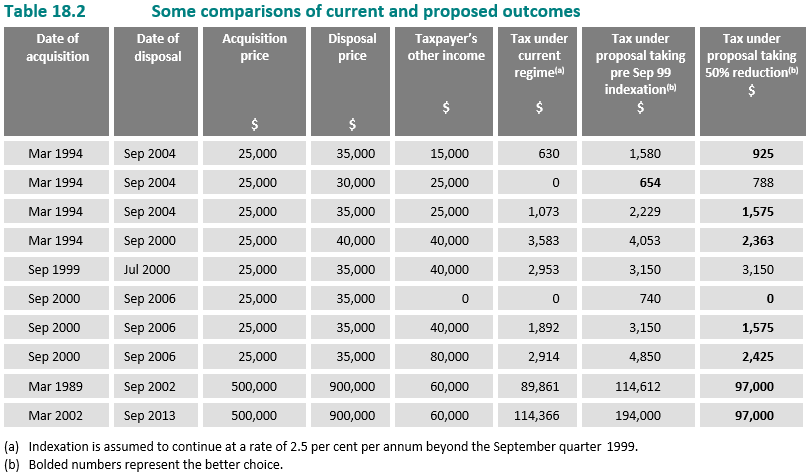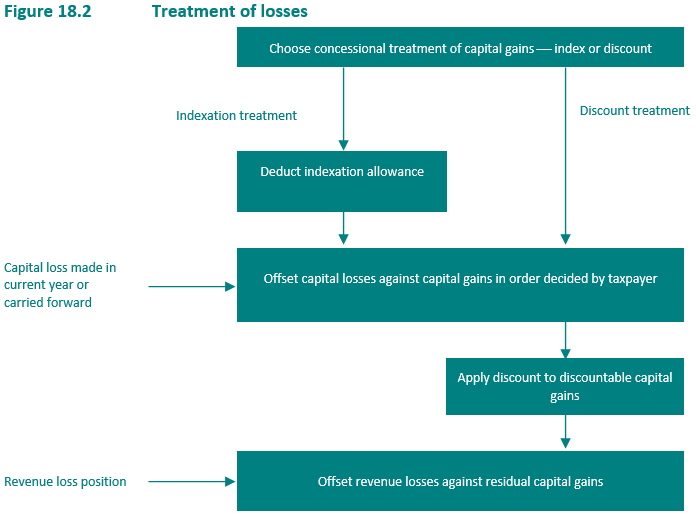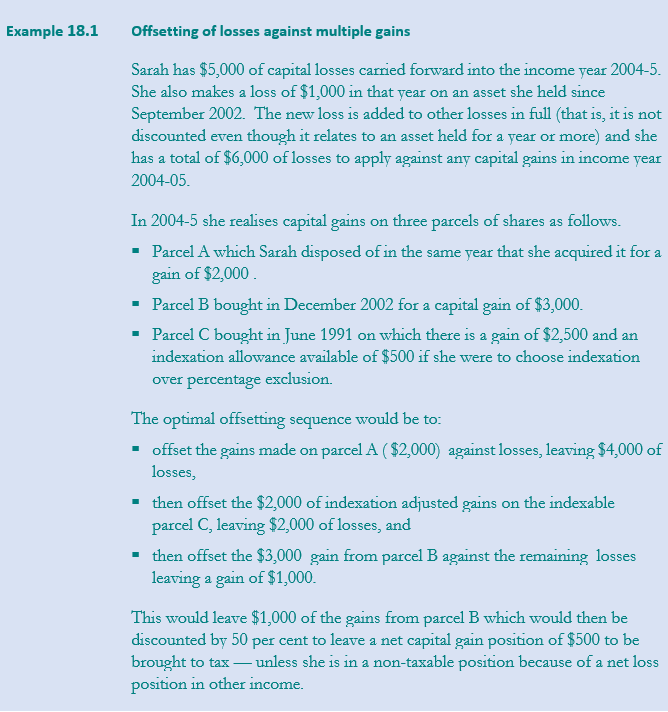Review of Business Taxation
A Tax System RedesignedMore certain, equitable and durable
Report July 1999
SECTION 18 - INCENTIVES FOR INVESTING
Reforming capital gains taxation
Recommendation 18.1 - Capital gains averaging and indexation
| Averaging abolished from date of announcement
Indexation frozen at 30 September 1999 for all taxpayers
|
Recommendation 18.2 - Capital gains taxation for individuals
| Option for individuals to include half of realised nominal gains in income
Option for individuals to include gains net of frozen indexation
|
Recommendation 18.3 - Capital gains taxation for complying superannuation and related funds
|
That for all disposals after 30 September 1999, complying superannuation and related funds be allowed to include in their taxable income, in respect of the realisation directly by the fund of assets held for a year or more:
|
Recommendation 18.4 - Treatment of capital losses
|
That for all disposals after 30 September 1999 of eligible assets (see Recommendation 4.10) held for a year or more at the time of disposal:
Capital losses able to be offset in any order
Where offset against gains net of frozen indexation
Where offset against gains not based on frozen indexation
Residual capital gains
|
Recommendation 18.5 - Treatment of revenue losses
|
That revenue losses be offset against capital gains realised after 30 September 1999 on eligible assets:
|
Recommendation 18.6 - Treatment of capital gains from trusts and CIVs
| Trusts to be subject to entity taxation
Trusts not to be subject to entity taxation
|
A structural shift in capital taxation for individuals
The Review's recommendations for capital gains taxation are designed to enliven and invigorate the Australian equities markets, to stimulate greater participation by individuals, and to achieve a better allocation of the nation's capital resources. In the first three or four years of the new regime there is likely to be considerable extra turnover on Australian equity markets as equity holders respond to reduced lock-in by realigning their portfolios. Even in the medium to longer-term, the Review expects a heightened level of realisations activity amongst individual shareholders and CIVs. The Review's recommendations in regard to scrip-for-scrip rollover will also stimulate significant turnover in the wake of expected increased takeover activity (see Recommendation 19.3).
The choice of option
A number of stepped rate scales to provide relief that increased with the holding period of the asset were discussed in A Platform for Consultation (page 291). Such an approach has the appeal that it provides a reward for 'patient capital'. However, there is an inherent tension between rewarding patient investors and seeking to free up capital markets. Realisation-based capital gains tax systems generally suffer from a tendency to lock asset holders into less than optimal positions. Providing any further reward for delaying realisation (for example, by means of a stepped rate related to holding period) would, in some cases, exacerbate the lock-in effect.
In consultation with business - especially the venture capital industries - it has also become clear to the Review that start-up ventures proceed through various stages, often needing to have capital restructurings even after only a few years in order to fund further development. A stepped rate scale would not appropriately reward shorter term investment at each such stage of the venture's development.
For these reasons, the Review has decided to recommend a broad form of CGT relief which has only a limited relationship to the period of holding of the asset.
The Review's recommendation of an exclusion of 50 per cent of capital gains for eligible assets held for a year or more by individuals will increase significantly the attractiveness of investing in capital-gains-bearing assets by individuals (see Recommendation 18.2). It will reduce the effective top marginal rate on capital gains income to 24.25 per cent.
Table 18.1 sets out the effective impact at each of the marginal rates for individuals to apply from 1 July 2000. The rates in this table are rates of tax applicable to the marginal dollar of taxable capital gain. If the present regime continued, the rates applicable would be the same as for ordinary income while the Review's proposal would effectively halve those rates. Indexation and averaging under the current regime cause the average rate applicable to any given taxable gain to be lower than the rate on the marginal dollar.
The assets that will be subject to this capital gains treatment are specified in Recommendation 4.10. There is a very close match between assets currently subject to the CGT regime and the assets eligible for the new capital gains treatment.

The offsetting adjustments
In order to deliver such a deep reduction in effective rates within the constraint of revenue neutrality, the Review has necessarily had to identify other features of the current regime which do not contribute to the objectives of encouraging investment or removing inflexibilities in the capital markets.
Australia's averaging provisions were identified early as contributing little to these aims while reducing revenue substantially. They are used by a section of the asset-holding community to reduce capital gains taxation to zero, or near to zero, while others who are not in a position to engineer the same benefit carry the burden of taxation at close to their full marginal rate. This results in considerable inequity. In practice, investors facing high marginal rates of tax remain locked in to a significant extent rather than realise and, where realising, have to secure a much higher return on the reduced capital available for reinvestment. Some individuals, of course, achieve a very low tax rate on capital gains through the averaging provisions and that may encourage more investment by such people. But the Review is not convinced that overall efficiency is best promoted by present provisions.
Were averaging to remain for a period after announcement, the Review expects that many taxpayers would seek to structure their affairs in order to take full advantage of averaging in 1999-2000 while it remained available. Accordingly, the Review recommends removal of averaging in relation to any gain realised on sales contracted from the date of announcement (Recommendation 18.1(a)). This may create some complexity in the transition year for certain taxpayers and in the administration of the tax law. But the potential disruption to collections otherwise justifies this one-time complexity.
The freezing of indexation adjustments after the September quarter 1999 adjustment is the other major adjustment recommended by the Review to achieve revenue neutrality (Recommendation 18.1(b)).
The case for freezing indexation is not as clear cut as for averaging. Though indexation provides a significant reduction in effective rate for many taxpayers, this is probably not well recognised, especially amongst foreign investors. Indeed, the perception has been that the Australian tax system imposes tax at full income tax rates. Such misperceptions are not easily corrected and a change in the form of concession to something more akin to the types of concession available abroad would, in the Review's judgment, be more effective in attracting investors to Australian assets.
'Freezing' of indexation
The current CGT indexation arrangements will be preserved up to the September quarter 1999. Individuals or complying superannuation and related funds will have the choice on the sale of a CGT asset acquired before then to reduce nominal capital gain for tax purposes by either: the 'frozen' indexation amount to the end of the September quarter 1999; or 50 per cent of the gain in the case of individuals or one-third of the gain in the case of complying superannuation and related funds. So, a taxpayer who acquired a CGT asset in June 1995, for example, would retain indexation of its cost base from June quarter 1995 until September quarter 1999 and that indexation allowance would be available at the option of the taxpayer for use at the time of any future disposal or deemed disposal of the asset.
As the indexation allowance will not increase beyond September quarter 1999, taxpayers will increasingly find the alternative of including only half (or two-thirds for funds) of nominal gains in income a more attractive option.
Entities subject to the entity tax system - not collective investment vehicles or excluded trusts - will also have indexation frozen on their CGT assets after the September quarter 1999 adjustment. No indexation or percentage exclusion will apply to assets acquired by these entities after 30 June 1999. That will greatly simplify the tax arrangements for those entities without adversely affecting their investment decisions. These entities will benefit directly from the reduction in the company tax rate.
For entities, individuals and complying superannuation and related funds, pre-CGT assets will remain exempt from capital gains taxation regardless of when disposal occurs.
Collective Investment Vehicles
Investments in CIVs pose a specific design challenge because, once the CIV regime commences, the CIV investor will receive capital gains from both the realisation of assets held by the CIV and from the disposal of a membership interest in the CIV.
To avoid unnecessary complexity, capital gains realised by CIVs on the sale of their CGT assets from 1 July 2000 will attract the 50 per cent exclusion only - and not the alternative of the frozen indexation amount. CIV members, who are individuals, complying superannuation and related funds or other CIVs will, however, have the option of reducing the capital gain on the sale of their CIV units by either the percentage exclusion or the frozen indexation amount (Recommendation 18.2 and 18.3).
Superannuation and related funds
In relation to complying superannuation and related funds, the Review has sought to substitute an alternative to indexation for capital gains purposes which would leave superannuation investments with broadly similar taxation to current arrangements. The option of including two-thirds of nominal gains in taxable income as an election for superannuation and related funds will have that broad effect (Recommendation 18.3(i)). It will reduce the effective rate of taxation on realised capital gains for superannuation and related funds to 10 per cent. Like individuals, complying superannuation and related funds will have the option of excluding the frozen indexation amount from gains on CGT assets. The rate of tax on capital gains realised by superannuation and related funds compares closely with the lowest effective rate of tax (9.25 per cent) to apply under the Review's recommendations relating to taxable gains realised directly by an individual.
Trusts to be included in the entity system
As a transitional measure, the Government announced in A New Tax System that inflation gains on post-CGT assets held in trusts prior to the change to entity taxation would continue to attract current treatment, regardless of when the assets were disposed of.
To give exact effect to this commitment, in the context of the Review's recommendation for the freezing of indexation at the September 1999 level for other taxpayers, would leave a continuing complication in the tax system. One group of assets would continue to receive full indexation while for other assets only a truncated level of indexation would be available.
In order to harmonise the proposed system with the Government's commitment to an equitable transition to an entity regime for these trusts, the Review recommends that indexation applying to post-CGT assets in these trusts also be frozen at the September quarter 1999 level - and that, once the entity regime is in place, they be allowed to choose between a reduction of 50 per cent or the frozen indexation allowance.
Though the Government's commitment under A New Tax System was for prior treatment to be allowed on assets held up to the time of change to the entities regime (1 July 2000), that commitment was made at a time when foreseeable policy would have afforded no particular benefit to transferring assets into trusts from other entities prior to 1 July 2000. However, once the approach recommended by the Review is expected to apply, there will be a strong incentive to transfer assets into trusts (from companies and superannuation and related funds especially). Accordingly, the recommendation is for frozen indexation or a 50 per cent reduction to apply only to assets held by such trusts prior to the date of announcement.
Impact of the recommended options
Figure 18.1 sets out the treatment of capital gains in the transitional period and in the longer run.
The recommended options have been designed to ensure that taxpayers retain at least the benefit of indexation up to the time of the announcement of the change to taxation treatment. That indexation will place a floor under the extent of relief available on capital gains. But in the vast majority of cases, the extent of relief provided by the exclusion percentage will exceed accumulated indexation and so the taxpayer will prefer to take the exclusion percentage rather than indexation.

At the individual level, taxpayers who would have had substantial resort to the averaging provisions will see an increase in tax payable. The information available to the Review indicated that much of the use of these provisions went beyond the intent of the legislation. Others with assets which have shown a low rate of return relative to inflation might also see some increase on account of the loss of indexation. However, the effect of this loss, at its maximum, will only be the indexation allowance that would have applied after September 1999. The election for excluding from taxable income half of nominal gains is regarded as being more than a worthwhile offset.
Table 18.2 provides some examples of the change to taxation that would apply to some typical taxpayers and asset realisations.

Impact on farmers and small business trading as individuals
In the consultation process, the National Farmers' Federation (NFF) expressed considerable concern about the impact upon farmers of the removal of indexation. The sort of concern they had was illustrated in an example published by the NFF on 1 June 1999:
Assume a farmer purchased a farm for $500,000 in September 1985 [i.e. after the commencement of the CGT regime]. If they sold it for $850,631 in September 1998, they would not have been liable for CGT - the increase in value of the farm would merely have kept pace with inflation. If there were a 30 per cent cap on the CGT rate and no indexation, they would have paid $105,189 in capital gains tax. The farmer would be worse off under the current regime (assuming a 48.5 per cent tax rate on the entire gain) only if the farm were sold for more than $1,419,222.
One of the central concerns implicit in the NFF illustration will be met by the Review's recommendation. It preserves any indexation inherited from the high inflation period of the late 1980s and so a farmer now carrying a large indexation allowance relative to gain into the new regime will still be able to enjoy that benefit. The foreseeable future is not likely to have rates of inflation similar to those that prevailed in the late eighties and early nineties. This would mean that a farmer who held a property in this period of low inflation would not be likely to value indexation as highly as the proposed discount. The last example in Table 18.2 is of that nature.
In addition, when most farmers dispose of their properties they have access to small business capital gains exemptions and rollover relief which mitigate the tax burden even further. In this regard as well, the Review's recommendations for small business capital gains exemptions and rollover are likely to be of greater benefit to farmers (and other small business people) than are the present arrangements.
Of particular potential benefit is the proposal to allow a small business capital gains exemption of 50 per cent in addition to the 50 per cent to be allowed generally (see Recommendations 17.5 and 17.6). This measure replaces the present 50 per cent exemption that applies only to gains on goodwill which generally do not account for all the gains in a business - especially for farmers. The proposed application of this relief to all gains on sale is of greater value to small business and will be of particular benefit to farmers.
A simplified tax system will also apply to small businesses with an annual turnover or annual receipts of less than $1 million (see Recommendation 17.1). This comprises a cash accounting regime, a simplified depreciation regime and a simplified taxation treatment for trading stock (including livestock).
Losses
The Review's proposals for the treatment of losses (see Recommendations 18.4 and 18.5) are set out in Figure 18.2 and illustrated in Example 18.1. Capital gains attracting indexation will have the indexation allowance netted off before being applied against any losses. Other gains (that is, gains not indexed and so eligible for the percentage exclusion) will have losses applied against them prior to any percentage reduction (that is, a half for individuals and a third for superannuation and related funds). The order of offsetting will be at the option of the taxpayer. In normal circumstances, the taxpayer will probably choose first to offset losses against indexable gains or gains made on assets held for less than one year and then to offset losses against gains that can be reduced by the percentage exclusion but have no indexation component available.


Copyright notice
© Australian Taxation Office for the Commonwealth of Australia
You are free to copy, adapt, modify, transmit and distribute material on this website as you wish (but not in any way that suggests the ATO or the Commonwealth endorses you or any of your services or products).
